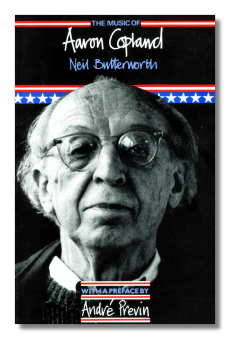
The Internet's Premier Classical Music Source
Related Links
-
Introduction
Acoustics
Ballet
Biographies
Chamber Music
Composers & Composition
Conducting
Criticism & Commentary
Discographies & CD Guides
Fiction
History
Humor
Illustrations & Photos
Instrumental
Lieder
Music Appreciation
Music Education
Music Industry
Music and the Mind
Opera
Orchestration
Reference Works
Scores
Thematic Indices
Theory & Analysis
Vocal Technique
Search Amazon
Recommended Links
Site News
 Book Review
Book Review
The Music of Aaron Copland

Neil Butterworth
Preface by André Previn
London: Toccata Press. 1985. 262 pp
Also available directly from publisher.
One of a series of books by the Toccata Press, first published in England, now being made available in the U.S., this volume serves as a fine listener's guide to the music of Aaron Copland.
The author writes "My intention has been to provide an introduction to his music to whet the appetite – which I hope will add to an increased interest in his works."
The focus of the book is clearly the music of Copland. Very little biographical information is supplied unless some event in his life had an obvious effect on a specific composition. Each work is taken in a roughly chronological order. Early and unpublished works are given less attention. The analytical discussion is quite simple and requires only a very basic understanding of the vernacular of music. The bulk of it reads like a set of program notes on each piece. Several quotes from the composer are included which adds a great deal of insight into the thinking of Copland.
There were but a few points in the book that I would question from a factual standpoint. In speaking about Copland's Third Symphony, Butterworth states "The haste in finishing the score is indicated by the revision of the closing pages, where two short sections were omitted in later performances." Not having seen the original score, but having a broadcast recording of the Szell performance from 1947, one can hear several additional measures in the coda of the finale. According to the composer, these were first cut by Bernstein, without Copland's approval. Copland himself wrote that he later agreed to those changes and the piece was published with the cut. At the very least Butterworth's observation indicates that he has made the effort to look at the manuscripts and knows the music very well.
Appendix one includes a transcript of a discussion between composer, pianist Leo Smit, who recorded the Copland Piano Music and Copland. This was a highlight of the book for in many ways it captures much of the personality of Copland as I experienced on the few occasions I had to meet him. It also gives a good perspective on his approach to composition.
In conclusion, Butterworth's book is a fine companion to the two volume Copland-Perlis collaboration which covers the biographical information and remains essential reading about this most remarkable musician.
5 November 1997
Copyright © 1997 by Karl Miller.


















